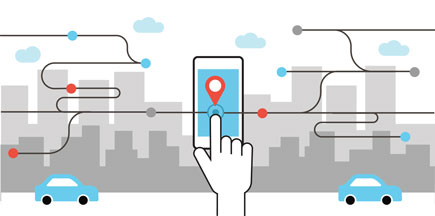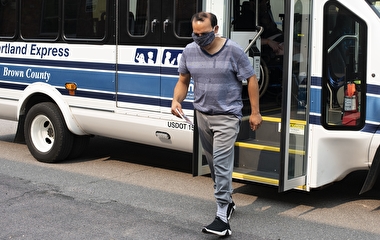Many of the challenges governments and transport authorities grapple with today stem from a broader restructuring of our economy and governance systems driven by private-platform technologies. In the opening session of the 2019 CTS Transportation Research Conference, SharedStreets co-director Kevin Webb explored how lessons from the past can help us manage emerging digital layers of the public realm.
“You can think of information platforms in much the same way you think about cities, because at the core they are about connectivity and how things are linked together,” Webb said. “The changes we’ve seen in the last decade are really about the role that connectivity plays.”
Webb explained that there are three ways to think about connectivity. First, connectivity is a technology that changes the way we experience proximity. “Modern cities could be considered a technology because they allow us to build social and economic systems through proximity,” Webb said. “Today, new technologies are lessening our dependence on spatial proximity.”
Connectivity can also be a business that enables us to do more—such as railroads, airlines, ride-sharing services, and even Amazon.
Businesses that operate infrastructure raise unique questions that point to the final way to think about connectivity: as a public good. These questions include: “How do we decide who operates the infrastructure?” and “How do we ensure it serves the public good?”
“As we build something transformative, it’s important to consider the ways we can make it work for the public purpose,” Webb said. “We saw that in the past with railroads and then roads, but today it is less about the actual physical infrastructure and more about the information layers on top of that. For example, ride-sharing services such as Uber are building data infrastructure on top of the road network.”
The good news, according to Webb, is that the challenges we face today in ensuring connectivity serves the public good aren’t new: long before the emergence of digital communication technologies, cities faced questions about how to regulate private-sector innovation in providing public services.
“The risk is that we miss the forest for the trees by treating this challenge as a technical problem or a mobility technology problem and failing to address it as the structural problem it is by using the already-existing structural interventions we have used in the past,” Webb added.
These existing leverage points fall into three main categories. Physical infrastructure interventions include capital investment, street and curb regulations, and pricing and subsidies for infrastructure use. People, vehicle, and goods interventions include driver and vehicle licensing and operating subsidies for services. Market and business interventions include pricing and utility regulations, labor and consumer protections, antitrust measures, and public investments. Of these three tools, Webb believes business and market interventions using proven measures such as innovative pricing regulation, dynamic infrastructure regulation, innovation in governance, labor protection, and privacy regulations are the most promising but underutilized tools for addressing these new and emerging challenges.
Using market and business interventions as a leverage point connects with the objective of SharedStreets—to preserve privacy while empowering cities, companies, and citizens with the digital tools and data needed to build future cities. At its core, SharedStreets is working to build an open-access modern map that is at the heart of emerging forms of urban connectivity and coordination—a data infrastructure that is part discovery infrastructure (like yellow pages), part information coordination infrastructure (social media), and part distribution infrastructure (the marketplace).
“We need to create new kinds of public utilities and define a right to collective agency and action through shared information,” Webb said. “We need to make bold public investments that commodify this core infrastructure to ensure it remains as a building block for others—preventing capture so that everyone can participate.”




